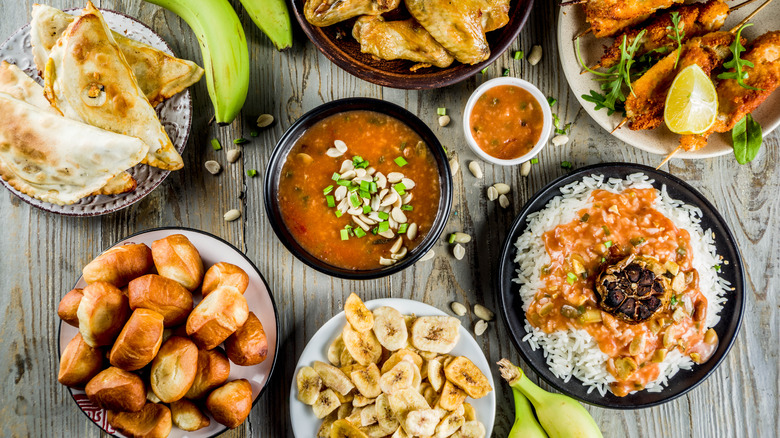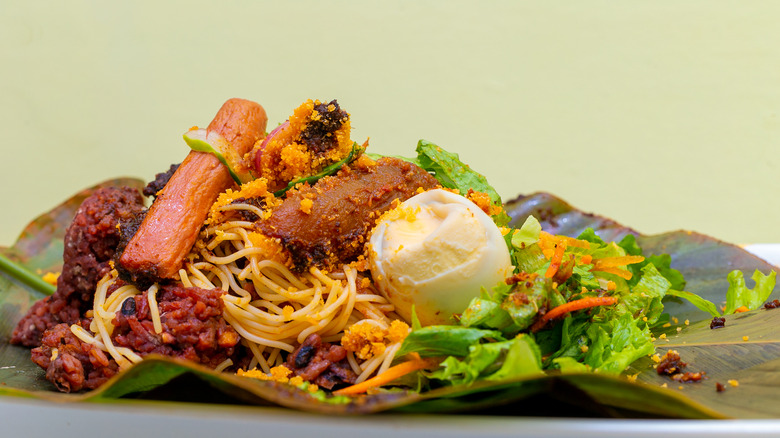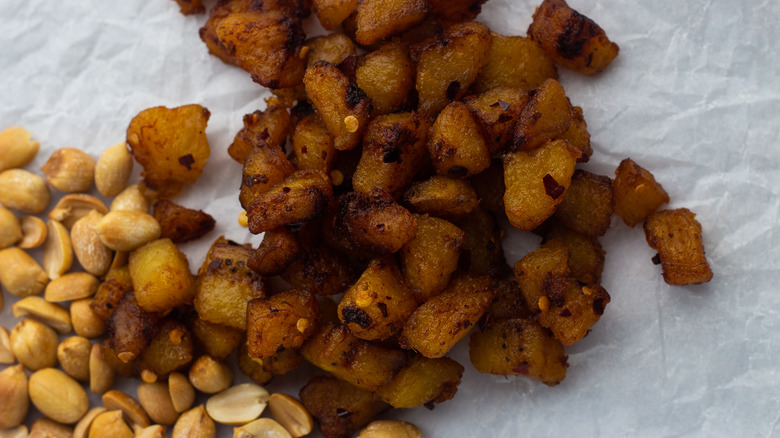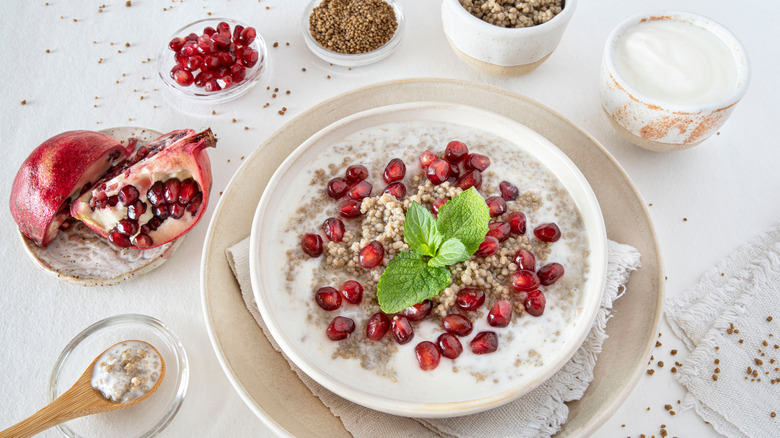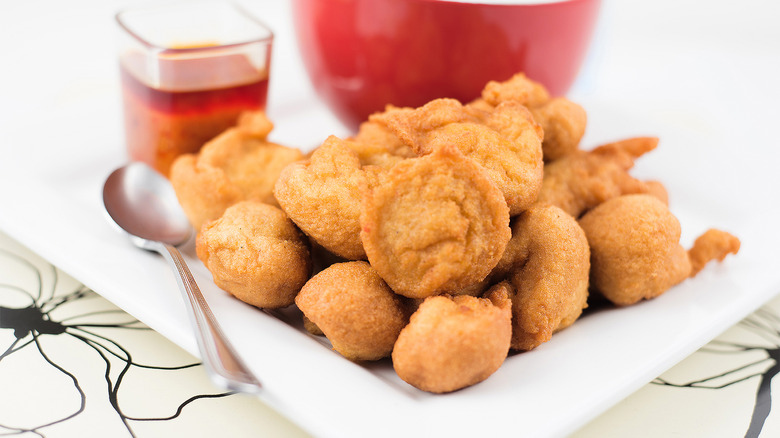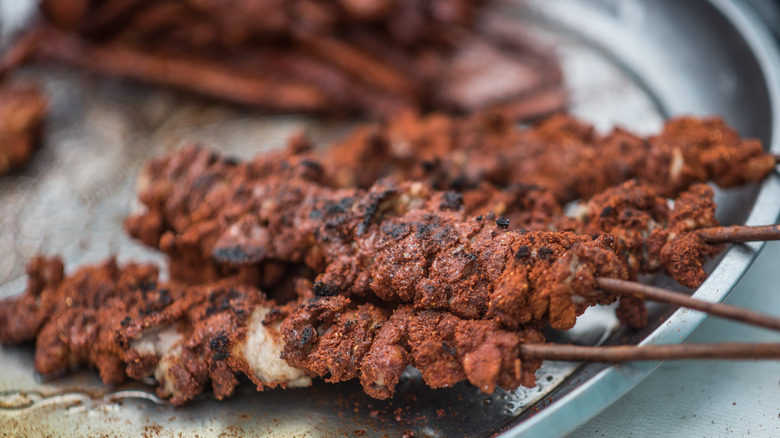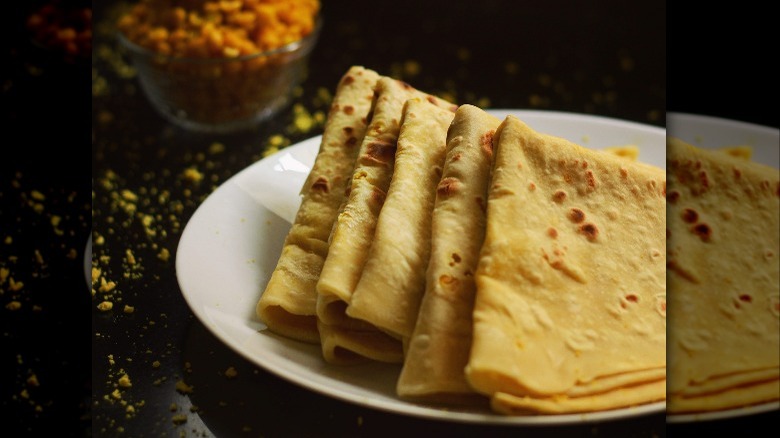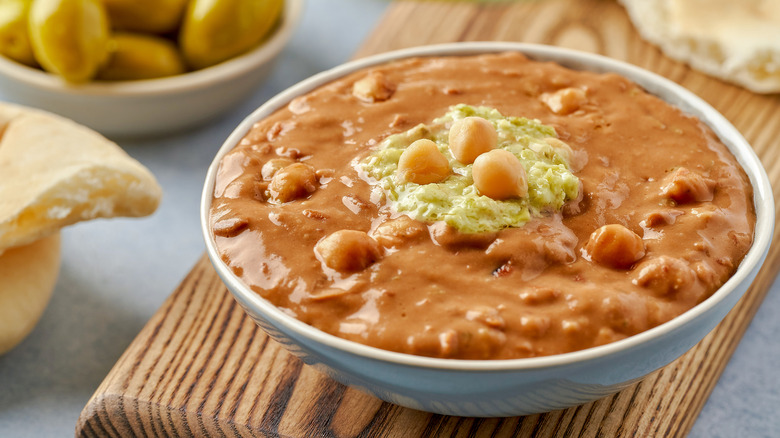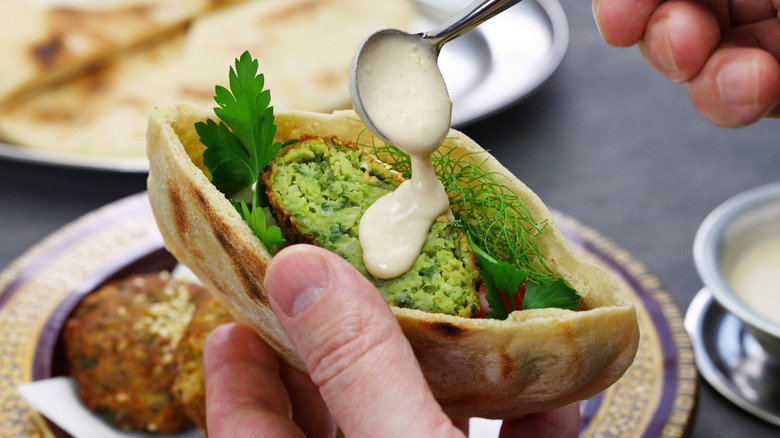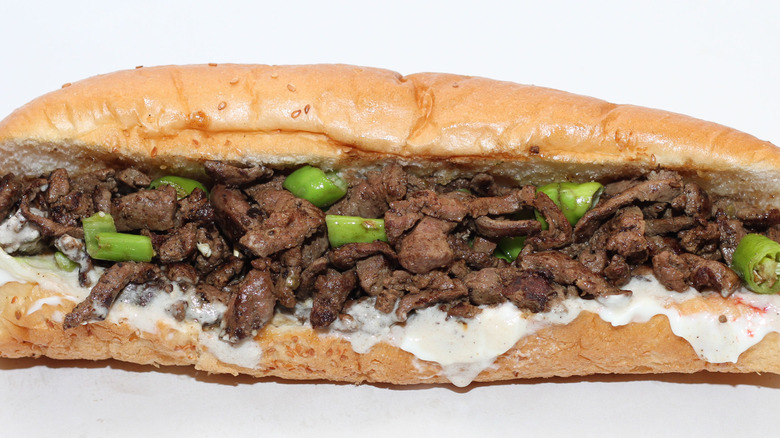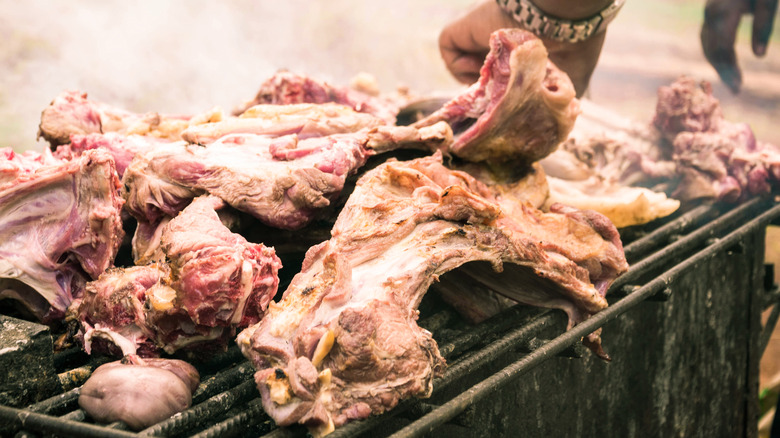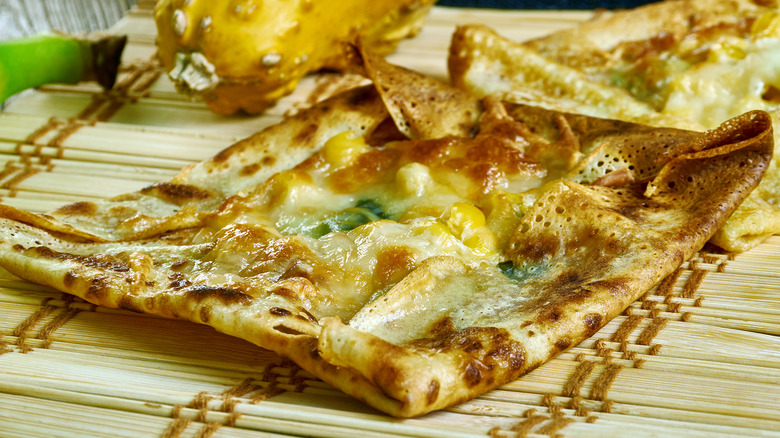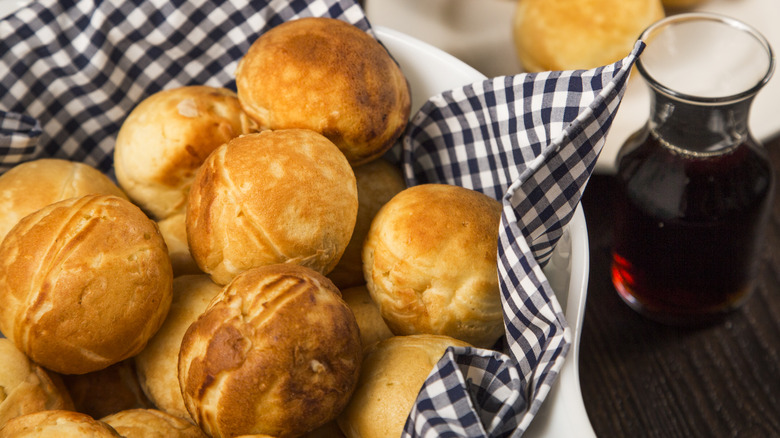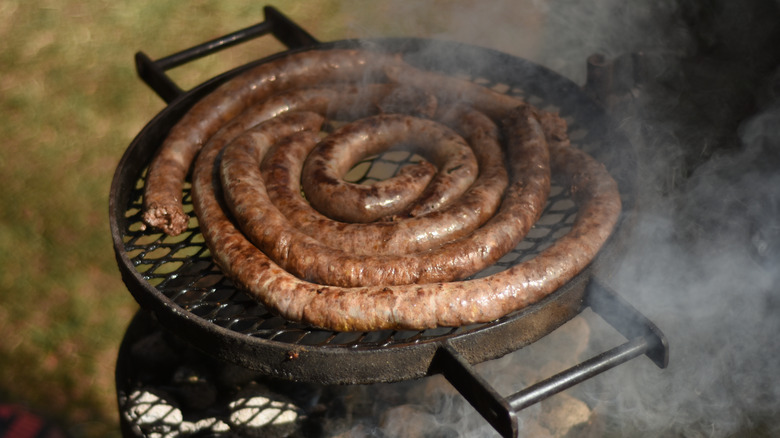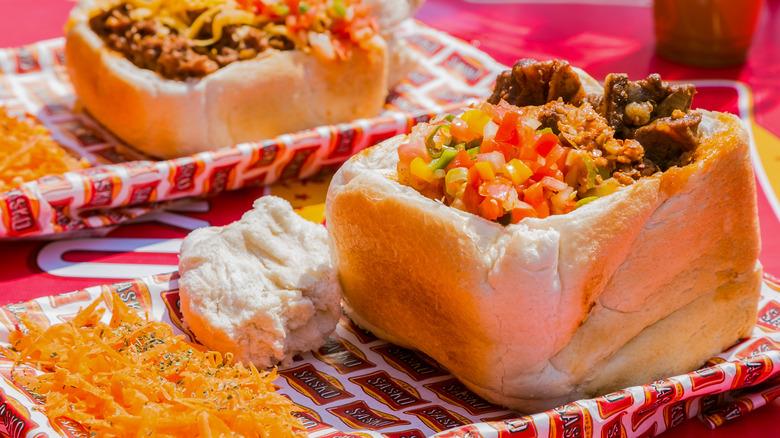Iconic Street Foods You Can Only Find In Africa
Africa is a vast continent positioned near the nexus of all four of Earth's hemispheres. African cuisine is typically divided into five regions – northern, southern, eastern, western, and central Africa – each characterized by their own distinct ingredients and styles of cooking (via Spices, Inc.).
Northern African cuisine, for instance, includes a lot of seafood, olives, and dates, which are indigenous to the region. Eastern African food is influenced by its proximity to the Middle East and easy access to spices. Central Africa makes use of peanuts, cassava, and plantains, while western African cuisine features a lot of rice, beans, and meat. And in southern Africa, you'll find eclectic cooking styles marked by a history of European and Indigenous influences. Much of the region can trace roots back to hunter-gatherer tribes, and still today people love a good "braai" — similar to a backyard barbecue in the United States.
No matter which region you're in, one of the most exciting places to experience African culture and cuisine is on the street. And hunting down the best local specialties can be a grand adventure that's full of surprises. But if you're not quite ready to fly across the globe just yet, read on for 14 must-try African street foods.
Waakye
Together, rice and beans create a complete protein, making them a convenient and nutritious duo. And in Ghana, West Africa, you can get them in the form of a beloved dish, often sold by street vendors, called waakye (pronounced "waa-chay"). This dish has a long history; it's likely that waakye became the parent of many popular rice and bean dishes throughout the Americas, like Jamaican rice and peas, after making its way across the Atlantic during the slave trade (per The Spruce Eats).
Waakye is usually made with black-eyed peas. The dish has a distinct red color, which comes from the addition of red sorghum leaves (sometimes referred to as millet leaves or waakye leaves) and an additive called kanwa, which is chemically similar to baking soda and helps soften and cook the beans faster.
Waakye is typically served in sturdy katemfe leaves, which can grow up to 2 feet long and nearly just as wide. The dish is popular for breakfast or lunch and is often served alongside other foods to round out the meal, such as fruit, pasta, eggs, chicken, or fish.
Kelewele
Another Ghanaian street food, one that you will sometimes find served along with waakye, is a spicy, fried plantain dish called kelewele (pronounced "kay-lay-way-lay"). People all over the world eat plantains, though they are especially popular in Africa and the Americas. The natural sweetness of a ripe plantain is often highlighted with things like sugar or honey and cinnamon. Not so with kelewele.
Every cook has their own preferred blend of spices to use when making kelewele, but common spices include salt, freshly grated ginger, and cayenne pepper. Other recipes might call for things like cinnamon, nutmeg, and lemon juice. Whatever the combination, this spicy mixture is tossed with chunks of plantain and then fried in a pan of hot oil.
Despite the oil used to make kelewele (the amount of which can be controlled), cooked plantains are generally good for your health. They promote the growth of beneficial bacteria in the large intestine, have a low glycemic index, are even higher in potassium than bananas, and contain other important vitamins and minerals (via WebMD).
Thiakry
If you are looking to soothe your sweet tooth in West African Senegal, thiakry (pronounced "cha-kree") is a must. This slightly sweet and creamy comfort food is popular for dessert, as a snack, or even for breakfast — and you may want to seek this dish out from multiple street vendors because there are a variety of different ways to make it.
The base of thiakry is traditionally millet couscous (per African Food Network). It is typically made with milk, sweetened condensed milk, yogurt (giving the flavor a light tanginess), or some combination of the three. The dish can be topped with spices like cinnamon or nutmeg, chopped nuts, fresh or dried fruits, and shredded coconut.
If you are lactose-intolerant but still want to try this delicious treat, there are dairy-free recipes out there to help you make thiakry at home. And it's worth noting that millet is naturally gluten-free.
Akara
A popular fried breakfast food that you'll find across West Africa is akara. Originating in Nigeria, akara means "pastry" in the Yoruba language, which is the native tribe of the region. Akara is basically bean cakes or fritters (typically made with black-eyed peas) that are deep fried to golden perfection. Akara is often eaten with bread as a sandwich or with some kind of porridge, but is also often consumed all by itself as a tasty snack. The dish has special significance in Yoruba culture; it is often passed out when a person aged 70 or older has died.
Today, you can find unique versions of akara in several different West African countries — including Sierra Leone, Ghana, Togo, Benin, and more — each with their own distinct ingredients and even names. The dish has also made its way to Brazil, as well as many countries in the Caribbean.
Suya
Suya — spiced, skewered, and grilled meat — is popular in Nigeria and other parts of West Africa. Suya originated with animal herders in northern Nigeria, and is traditionally made from beef and mutton. Today, it's sometimes made from chicken as well. The animal's innards, such as the liver, are also sometimes used as well. The type of meat and the spices used in the rubs vary by region as well as taste, but peanuts are almost always used in this traditional dish. Other common flavorings include ginger, chili pepper, paprika, nutmeg, and salt.
Suya is pretty easy to prepare, which is part of what makes it so popular as a street food. The meat is sliced, rubbed with or marinated in the spice mixture, skewered, and then grilled. The heady aroma that arises is all that's needed to draw in hungry customers. And if you're making it at home, you can even cook the meat in the oven, so the gloriously spicy smells fills up your kitchen.
Dholl puri
In the Indian Ocean off the eastern coast of Africa sits the small island nation of Mauritius. With two-thirds of the population of the island being of Indo-Pakistani descent, the food culture there is a little different than you might expect from an African country.
Take popular street food dholl puri. The stuffed, pan-fried flatbreads (derived from the similar Indian dish, paratha) were introduced to the island by immigrant workers more than 100 years ago (via The Guardian). Dholl puri is often seasoned with cumin and turmeric and, like a taco, can be stuffed with just about anything. Some popular choices include fish, venison, butter bean curry, and split yellow peas.
Typically, an order of dholl puri comes with two flatbreads, wrapped in paper, served up to-go with a soda to wash it all down. They are often eaten with pickled vegetables or chutney, and used as a side dish for curries. Not only is dholl puri a ubiquitous street food, but the dish is also regularly consumed at weddings and other celebrations (via Taste Atlas).
Ful medames
Ful medames is a popular, traditional breakfast (or any time of the day) food in Egypt, possibly dating all the way back to ancient times (via Epicurious). It is a nutritious dish sold all over the country, in restaurants and by street vendors alike. The main ingredient in ful medames is fava beans, which are high in protein, fiber, iron, and other important vitamins and minerals (via WebMD).
To make ful medames, fava beans are traditionally cooked overnight in giant metal jugs to make them extremely tender. The soft beans are then mashed together with ingredients like olive oil, garlic, chili flakes, and salt. Finally, the bean mash is finished with toppings such as tomatoes and onions, pickled carrots, chopped parsley, melted butter, or a squeeze of lemon juice. Arab bread (basically pita bread) is often served on the side or can be used to make a ful medames sandwich.
Ta'ameya
Another popular and uniquely Egyptian street food is ta'ameya (pronounced "taa-mey-a"). It is similar to falafel, but like ful medames, ta'ameya is made from fava beans rather than chickpeas. Many actually claim that ta'ameya was invented prior to falafel, dating back at least 1,000 years, but the regional debate runs deep (via Taste Atlas). Adding to the rivalry, some say the use of fava beans over chickpeas results in a more pillowy and moist fritter.
Ta'ameya is commonly eaten for breakfast, and also makes for a great vegetarian snack. First, fava beans are soaked overnight to soften them. Then, the beans are pounded (if you're sticking with the traditional method) or blended with an electric blender or food processor into a dough along with red onion, fresh herbs, garlic, coriander, cumin, and salt. The dough is formed into little balls, sometimes rolled in toasted sesame seeds, and fried in oil. The hot and fresh ta'ameya is often wrapped in pita bread and finished with any number of toppings, including tomato, lettuce, pickles, hummus, tahini, and yogurt.
Kebda eskandarani
The quintessential Egyptian sandwich is the kebda eskandarani. It literally means Alexandrian Liver. While no one is certain of the precise backstory, it is assumed the sandwich originated in Alexandria, hence its name. It remains popular in the sprawling port city, but it can now be found all across Egypt.
Originally made using livers from water buffalo, nowadays, any animal liver can be used to make kebda eskandarani, including beef, venison, or duck (via The Intrepid Eater). The liver is chopped and then fried with various spices. To finish, the meat is heaped onto a long bun and topped with onions, peppers, and tahini. If you aren't interested in the portability of a sandwich, the liver can also be served by itself with rice or pita bread on the side.
Any way you decide to try it, kebda eskandarani pairs well with a refreshing Egyptian cucumber and tomato salad, known as salata baladi, to round out the meal. And it's worth noting the liver can be prepared with various levels of heat and spice, so the salad may help cool down your taste buds.
Nyama choma
A popular street food sold by roadside vendors in Kenya and Tanzania is nyama choma, which simply means "barbecued meat" in the African language of Swahili (via Taste Atlas). Nyama choma is made with either marinated goat or beef. The meat is usually cut into chunks and skewered before it hits the grill, but larger cuts might be roasted whole. Sometimes, only salt is used in the marinade, but lemon and a variety of spices may also be added for extra flavor. The meat is then grilled outdoors over coals until it's tender and juicy.
Much like throwing a backyard barbecue in the U.S., making nyama choma is also an excuse to get together with friends and family or celebrate a special occasion (via Tried & True). Nyama choma is often paired with ugali, a traditional Kenyan cornmeal porridge, and colorful kachumbari, a salad predominantly made with fresh tomatoes and onions.
Zanzibar pizza
How can anyone pass up the chance to try something with pizza in its name? For a unique twist on this global favorite, look to the African island of Zanzibar, located in the Indian Ocean off the coast of Tanzania.
Their signature pizza bears only a superficial resemblance to the Italian or American versions. It looks more like a crepe or a savory pancake. The preparation is similar, however (via Atlas Obscura). It starts with a ball of dough that gets flattened, then layered with another small piece of dough for durability. Next comes the toppings: meat, vegetables, herbs, and savory spices. Or you can go the sweet route with Nutella and fresh fruit. Zanzibar pizza is also often topped with a soft, white cheese. After all your toppings are added, the sides are folded up and the pizza is fried in clarified butter in a large pan, then served fresh and crisp for your enjoyment.
Mofo gasy
Mofo gasy (pronounced "muf gas") is Madagascar's version of the bite size pillowy pancakes you find across cultures (think aebleskivers, dumplings, doughnuts, paniyaram, and more).
Because rice is Madagascar's top grown crop, it features in much of their cuisine (via Encyclopaedia Britannica). Mofo gasy is no exception. A blend of wheat flour and cream of rice is used to make dough, along with other ingredients that give some sweetness to the dish. There is also a version of mofo gasy made with coconut milk, known as mokary. Vendors traditionally use a special pan with circular molds and cook the mofo gasy over a charcoal grill (via Cook's Hideout). The cooked, crispy mofo gasy can be eaten plain or with a drizzle of syrup. Basically, however you would eat pancakes, you can also eat mofo gasy. To round out your meal, grab a cup of coffee or tea and some fresh fruit, and breakfast is served.
Boerewors rolls
Boerewors (pronounced "boo-ruh vors") is Afrikaans for "farmer's sausage," and it's a must at every braai (remember, that's the South African version of a backyard barbecue). It's also a popular street food in South Africa. The main difference between boerewors and traditional sausage is that boerewors has a higher meat content. And when it's sizzling on a grill or in a hot pan, the blend of ground beef and pork, along with spices like black pepper, coriander, nutmeg, and allspice, smells simply mouthwatering (via Honest Cooking).
Boerewors is sometimes compared to hot dogs in the U.S. The long, coiled roll of meat is ofte cut into smaller pieces, put on a sliced roll or a bun, and topped with fried onions, mustard, relish, or whatever you want — just like a hot dog! Of course, it can also be eaten without the bun, too. Popular sides include coleslaw and pap, a traditional grits-like porridge made from milled white corn.
Bunny chow
The history of this interestingly named, beloved South African dish is murky at best. Bunny chow has existed in Durban, South Africa for the better part of the last century and has spread to the rest of the country (via Culture Trip). If you don't want to sound like a tourist, just call the dish a bunny. Everyone will understand you.
These bunnies are a unique kind of bread bowl. A quarter, half, or full (if you are really hungry) loaf of crusty bread is hollowed out, then filled with curry and beans. The proper way to eat a bunny is with your fingers (so have plenty of napkins handy), starting with the hunk of bread on the top. A bunny is typically made from the end of a loaf. And take note: versions made using the middle of the loaf are known as funny bunnies, and may result in a soggy bottom.
You should also keep in mind that because bunny chow is filled with curry, it will likely be spicy. Maybe cool down your mouth with a side of shaved carrots, or a cold beer or soft drink.
